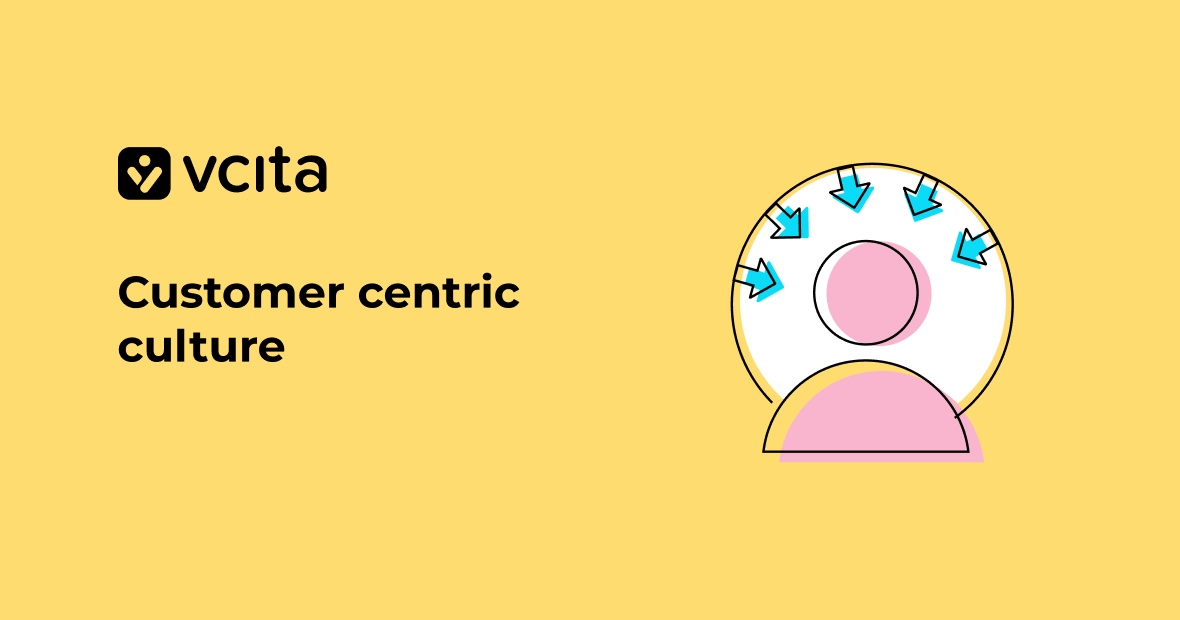You’ve set up your small business and it’s going pretty well, but you think you could be doing better. One key to turning your business into a major success is to create a customer-centric culture in your company. Businesses that have a customer-centric culture generally enjoy increased loyalty and greater customer satisfaction, which translates into more sales, more new customers, and more revenue.
Building a customer-centric culture might sound challenging, but there are concrete steps for you to take to achieve it, like preparing ideal customer profiles (ICPs), applying purpose-driven marketing, and offering an outstanding digital customer experience. Read on to how your business can benefit from a customer-centric culture, and what you need to do to make it a reality.
What is customer-centric culture, and why does it matter?
A customer-centric culture is when a company focuses on creating an amazing experience for customers. It’s about really listening to clients and proactively asking for their feedback, so that you can understand their needs better, and then using the information to offer products, services, and experiences that fill their requirements. When your business implements a customer-centric culture, it means you’ll consistently prioritize your customer’s expectations, every time they interact with your company.
Businesses that adopt a customer-centric culture see a direct correlation with long-term success, enhanced customer loyalty, and sustainable growth. Businesses that listen more closely to customers enjoy greater visibility into and understanding of their preferences and pain points. This gives them the power to customize their offering to be more relevant.
In this way, a customer-focused approach fosters stronger relationships and cultivates increased brand loyalty. These lead to repeat purchases and positive word-of-mouth recommendations, which are crucial for sustained profitability.
What’s more, a customer-centric culture drives innovation and agility within organizations. By consistently gathering feedback and insights, businesses can anticipate evolving customer needs and changing market dynamics, staying ahead of the competition and positioning themselves as industry leaders.
Ultimately, a customer-centric culture creates a positive feedback loop where satisfied customers drive business success through increased sales, improved brand reputation, and ongoing innovation, establishing a foundation for higher profits, lasting competitiveness, and sustained growth.
6 steps for creating a customer-centric culture in your small business
Building a customer-centric culture means making customers your top priority. Here are 6 actionable steps for you to follow to achieve this goal.
1. Leverage ideal customer profiles
One key step is to create ideal customer profiles, or ICPs. These are personas you can use to focus your service development, marketing, and business messaging. To create an ICP, first gather and analyze data about your existing market base, so you can see what commonalities are shared across your top customers.
When you see clear patterns that define your best customer, turn them into an imaginary persona that you can use to develop a purpose-driven marketing strategy that’s focused on meeting their needs. For example, if you run an exercise studio, ask clients what kinds of workouts they’d prefer, and if they would rather come to morning sessions or evening sessions. Build those into your offerings and promotions.
2. Go all-in on communication
Communication is a key element of customer-centric culture, so make sure it’s easy for customers to reach you or other members of your team. Integrate features like live chat on your website, so customers can ask questions and get answers fast, and check your phone, email, and social media frequently.
It can be a good idea to hire someone specifically to handle customer relations, so you can respond quickly to questions and reviews and engagement on social media. You want to build a relationship, not just drive sales, so make an effort to get to know your customers as real people and show them you care about their needs beyond making a purchase.
3. Ensure customer processes are friction-free
Next, focus on delivering an amazing digital customer experience. If you have a website or mobile app, make sure it’s user-friendly, helpful, and visually appealing. Keep important tools like your booking widget in a prominent spot so that customers don’t have to hunt for it to make an appointment.
It helps to provide extra resources that add value to the customer experience, like FAQ sections, how-to guides, and video tutorials. The overall experience is what will keep customers coming back.
4. Prove you care about customer opinions
Be proactive in asking for feedback, like sending surveys or emails after a purchase, or calling customers directly. Talk to your customers regularly to find out what they want and need, and use what you learn to improve your product or service.
It’s also a good idea to involve your customers in decisions and create ways for them to share their ideas, like running polls to see which new product or service customers want. Letting clients help shape your business makes them feel invested in your success.
5. Ensure employees are on the same page
Hire the right team. Your staff represents your brand, so choose employees who share your customer-centric mission and have vital soft skills like communication, initiative, and teamwork. With an enthusiastic team, you’ll be able to provide amazing service.
It’s also important to empower employees to deal with difficult clients in a constructive way. Give them the authority and flexibility to resolve issues independently, then recognize their efforts. When employees feel supported in putting customers first, they’ll work hard to build loyalty and turn complaints into opportunities.
6. Measure your success
Track metrics like churn rate, net promoter score, and customer lifetime value to see what’s working and what needs to be improved. Channel what you learn back into your business decision-making, celebrate wins, learn from mistakes, and keep optimizing processes and services to better serve your clients.
Using ideal customer profiles to build strong relationships
As mentioned above, ICPs are a crucial tool in building a customer-centric culture and achieving long-term success. Using ideal customer profiles helps you identify the companies and clients that are the best fit for your business. They ensure you’re targeting the right customers, which lowers the risk of churn and maximizes the potential for brand evangelists. Brand evangelists are enthusiasts about your business, who promote it frequently to their friends, family, and social media connections.
Analyze the attributes of your most loyal and profitable clients to determine common characteristics. Look at factors like age, profession, location, and key challenges. The more you understand about your ideal customers’ needs, priorities and buying processes, the better you can tailor your marketing and sales efforts to them.
Creating purpose-driven marketing that resonates with your target audience
Purpose-driven marketing campaigns are an important element in the process of building a loyal audience that aligns with your core values and resonates with your target customers. Here are 5 steps to preparing a purpose-driven marketing strategy.
- Get to know your customers
Conduct surveys and interviews to gain insights into your customers’ needs, values, and interests. Create ideal customer profiles that represent your key customer segments. These profiles will help ensure your marketing messages speak to their priorities.
- Define your business’ purpose
Why did you start your business? What social causes or values drive you? Craft a purpose statement that conveys your meaningful motivation for the work you do. Let this purpose guide your marketing and business decisions.
- Build authentic campaigns
Develop marketing campaigns that genuinely reflect your purpose and values. Highlight the social impact of your products or services, and share stories of real customers and how you’ve made a difference in their lives. Transparency and authenticity are key to earning trust and loyalty.
- Provide value
Focus on educating and empowering your customers rather than just selling to them. For example, send a monthly newsletter with useful tips and resources for your industry or niche. Host free webinars on important topics, and provide opportunities for your customers to connect and support each other. Adding value will strengthen your relationship.
- Listen and learn
Pay close attention to customer feedback, run surveys to measure satisfaction, and make continuous improvements based on what you hear. Read online reviews and social media comments, then address any legitimate concerns and look for ways to enhance the customer experience. Your customers will appreciate that you genuinely listen and care about their input.
Customer-centric businesses drive more revenue
A customer-centric culture takes an organization-wide effort. But the rewards of higher sales, more referrals, and a loyal customer base make it worth the work. Focus on relationships, communication, and experience, and put the customer first in all areas of your business. Soon you’ll see your happy customers driving more revenue and profits.




























